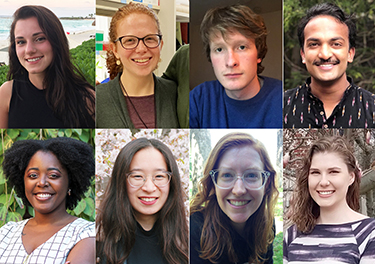 The National Science Foundation’s Graduate Research Fellowship award recognizes and supports outstanding graduate students in STEM disciplines. From algebraic geometry and developing sustainable polymers to quicker, more efficient DNA and RNA testing, these students look forward to continuing their research and to give back through mentoring and making science more accessible to all.
The National Science Foundation’s Graduate Research Fellowship award recognizes and supports outstanding graduate students in STEM disciplines. From algebraic geometry and developing sustainable polymers to quicker, more efficient DNA and RNA testing, these students look forward to continuing their research and to give back through mentoring and making science more accessible to all.
This year’s awardees include (pictured left to right, top to bottom): Helen Belato, Layra Cintrón-Rivera, Patrick Flynn, Siddarth Kannan, Kiara Lee, Lucy Qin, Amy Rutter and Audra Woodside.
"I’m extremely grateful, especially at a time like this, to have NSF’s financial support. I’m hopeful that this fellowship will help me forge new collaborations and focus on projects that prioritize the privacy concerns of groups traditionally overlooked in technology design,” says Lucy Qin.
As a first-year PhD student working in applied cryptography, Qin is part of a project to build a novel cryptographic protocol that will aid policymakers in advocating for explicit privacy guarantees in an upcoming legislative proposal.
Kiara Lee, a Biomedical Engineering student says, “being awarded a graduate fellowship has always been one of my goals. It is very rewarding to see my hard work pay off.” She was also selected for a Ford Foundation Predoctoral Fellowship.
Lee is studying the creation of low-cost diagnostic tools that extract DNA and RNA from small volumes of patient samples. When DNA and RNA testing can be completed with tools on site, rather than being sent off to a lab, fewer resources are used and the volume and speed of testing can expand. This is especially relevant to today’s COVID-19 crisis, where initially most testing required processing by a remote lab and results took several days to obtain.
Another awardee, Audra Woodside is focused on the development of novel catalyst systems incorporating rare earth metals towards the production of more sustainable polymers, which will ideally be more environmentally friendly.
“Receiving the NSF-GRFP allows me the opportunity to commit more time to research as well as participate in a variety of outreach programs, such as the American Chemical Society Project Seed, in an effort to make science more accessible to underrepresented students,” says Woodside.
Patrick Flynn, an applied mathematician, is studying the mathematical theory of solitary waves in plasma physics. Like Woodside, the award will allow him greater focus on his research and outreach.
In Mathematics, Siddarth Kannan is studying combinatorial algebraic geometry. His research involves translating questions about often mysterious and high-dimensional spaces into questions about tractable, discrete objects, such as graphs.
“The NSF award is a great honor and will certainly increase my flexibility to pursue multiple research directions. I also hope to become involved with mentoring undergraduate research at Brown,” says Kannan.
Helen Belato, a Molecular Pharmacology and Physiology student says the Fellowship has provided her with the “funding I need to create opportunities I will not find elsewhere; opportunities that will help me grow as an individual, expand my knowledge, but also keep my passion alive as I work toward a Ph.D.”
Belato’s studies focus on optimizing the efficiency of CRISPR-Cas9, a unique technology that enables researchers to edit parts of the genome, to help understand the mechanism that regulates the function of the Cas9 protein at atomic level resolution. Belato stresses that if the details are understood of how Cas9 is able to recognize and edit a target DNA sequence, then scientists have total control of it and can prevent off-target effects.
Also in the life sciences, Amy Rutter is excited that the fellowship will provide her greater freedom to push her research in new directions. She is focused on the biomechanics of woodpecker drumming and interested in understanding the physical processes behind the biological movements, with an emphasis on the muscles.
Pathobiology student Layra Cintrón-Rivera examines the zebrafish as a model to study cardiovascular development and to advance the understanding of developmental pathways and mechanisms.
“One of my goals is to help diversify the STEM field by educating, empowering, and motivating others to pursue science. Receiving the NSF-GRFP opens up new opportunities and avenues to accomplish this goal,” says Cintrón-Rivera.